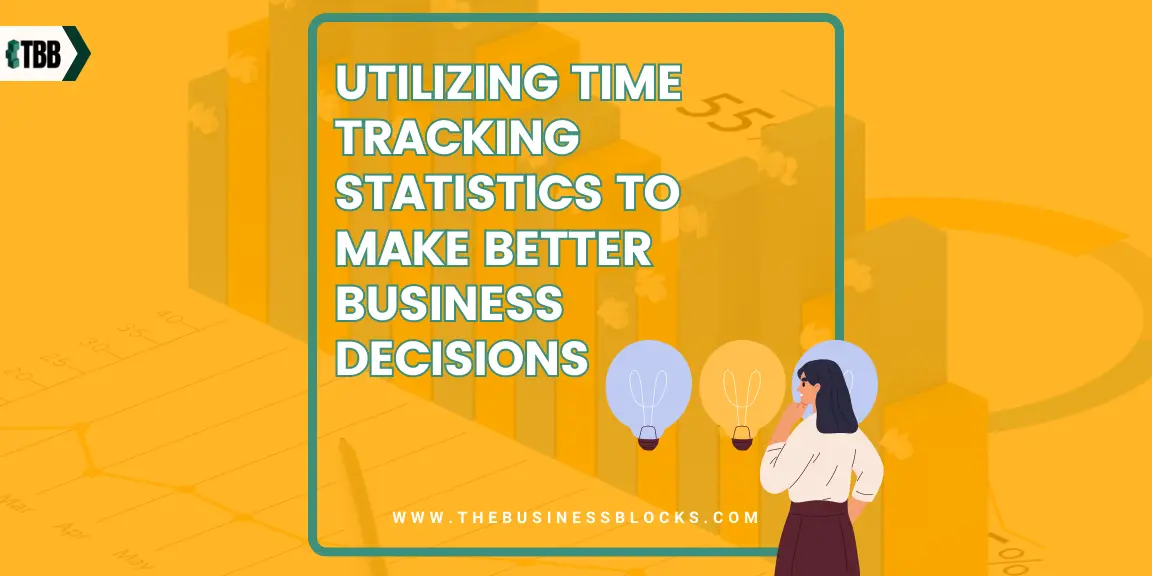Understanding how time is allocated inside an organization in today’s fast-paced, cutthroat environment is critical. Businesses may acquire insightful information into their operations, spot inefficiencies, streamline workflows, and ultimately boost productivity and profitability by utilizing the potential of time-tracking statistics.
Join us as we examine the many benefits and drawbacks of time tracking and learn useful tips for improving decision-making that can help your company soar.
Do you want to make more informed decisions in your business?
Businesses of all sizes can gain actionable visibility into their operations by tracking and analyzing critical data related to the time workers spend on tasks or projects. Critical Time-tracking statistics provide invaluable information organizations can use to measure performance and allocate resources more effectively.
With this insight, businesses can understand where they’re losing money due to inefficient processes and how they could best manage resources for improved results. Moreover, access to accurate data allows them to reduce costs by streamlining workflow and allocating funds more wisely.
Understanding the Basics of Time Tracking Statistics and Why They Matter?

Time tracking statistics involve collecting and analyzing data related to the time spent by employees on different tasks. By recording and analyzing this data, businesses can obtain insights into how time is allocated, spot inefficiencies, and boost productivity.
These facts simplify project planning, resource allocation, process optimization, and precise project estimation. They assist in assessing worker performance, establishing reasonable timetables, and reaching data-driven judgments. Businesses can use time tracking information to understand how they use their time, spot areas for improvement, and eventually increase their general effectiveness and profitability.
Benefits of Utilizing Time Tracking Statistics for Businesses
- Data on work time offers insights into a variety of work and company activities. It provides information on team and individual productivity, procedural effectiveness, project profitability, employee absence expenses, and more.
- It’s essential to identify problems early and resolve them. Owners can use time-tracking data to evaluate work progress, remaining tasks, and project budgets. It aids in the quick identification of issues for timely resolution.
- Establishing efficient procedures and routines can be done using time-track data analysis. It avoids time wastage, improves work effectiveness, and guarantees project delivery on schedule.
- It’s critical to calculate work, overtime, and absence hours accurately. Inaccurate computations cause conflicts. Accurate records facilitate managerial efficiency, automate calculations, and enable adherence to business policies.
Analyzing Key Performance Indicators (KPIs) to Make Effective Decisions
Let’s take a look at some employee time-tracking KPIs.
Daily productive time
The amount of time spent working each day is monitored by this KPI. Additionally, it gives supervisors access to information about the employee’s prior productive time, enabling them to evaluate and decide on their performance.
Overtime absenteeism
Unnecessary absences from a team member raise concerns for the company and the entire team. Productivity and team morale may suffer as a result. Thanks to this KPI, managers can easily track employee absences.
Overtime work
Working extra hours can hurt a worker’s health and productivity. Monitoring and stopping this negative tendency early on is possible by employing KPI tracking tools.
Utilization rate per employee
The utilization rate is calculated using the following straightforward formula:
[Billable hours / Total hours logged by an employee]
It enables the business to monitor employee performance and assess their progress, which is crucial to achieving a high conversion rate per employee.
Average task completion rate
This KPI uses the following formula to calculate this perimeter to measure efficiency:
[Average task completion rate = Total time taken to complete tasks/number of attempts]
It enables the business to assess a worker’s overall performance.
Revenue per employee
This KPI might estimate a team member’s earnings for the company. It provides the business with a clear net profit margin per employee.
Organizations frequently use this KPI to determine annual earnings, but depending on the objectives, it may also be used to determine quarterly or monthly profitability.
Creating Strategies and Goals Based on Time Tracking Statistics
Developing goals and strategies based on time-tracking information is important to increase productivity and efficiency. Individuals and organizations can learn a lot about their work habits and pinpoint areas for development by carefully analyzing the time spent on various tasks and activities. The data analysis can help formulate a strategic plan and help the business make informed decisions.
For instance, if statistics show that much time is spent on low-value jobs, efforts can be shifted towards more significant activities. In addition, time-tracking statistics make it possible to define attainable objectives. Setting clear goals and efficiently distributing resources is possible by understanding how time is used and spotting bottlenecks or inefficiencies.
Implementing Automated Solutions for Time Tracking Statistics

Automated time-tracking statistics implementation can change how people and businesses manage their time and increase productivity. Various software programs and tools that can automatically track and analyze time spent on various jobs and activities are now available, thanks to technological improvements. These solutions do away with manual tracking, which lowers human error and frees up crucial time.
Users can easily collect reliable data on their actions by integrating time-tracking software into processes, giving a thorough insight into how time is used. In addition to real-time insights and adaptable reports, automated solutions enable customers to examine their productivity trends and pinpoint areas for development.
Additionally, these technologies may produce intricate visualizations and statistics, making it simpler to spot time-wasting tasks or process bottlenecks. Individuals and organizations can streamline processes, optimize resource allocation, and improve efficiency and performance by introducing automated systems for time-tracking data.
Different Types of Time-tracking Statistics
The time-tracking software industry offers various statistics that help evaluate worker performance. Let’s take a look at some of them.
Average hours worked per day
This metric helps to understand how many hours an employee works daily and assess their overall productivity level. Time theft and working hours can be monitored to ensure workers complete tasks efficiently.
Average billable hours
The amount of time spent on billable activities and hours a week is measured by this KPI. It can be used to track employee profitability and the effectiveness of their efforts. Time management skills and work habits can be evaluated using this statistic.
Average hours worked/project
This KPI enables businesses to evaluate team productivity on each project. It clearly explains how much time was spent on a specific task. This enables businesses to identify team issues and create improvement strategies.
Average task completion rate
This metric measures the efficiency of an employee’s task completion rate. It is calculated by dividing the total time spent on tasks by the number of successful attempts. This KPI helps employee productivity and helps managers identify efficient and inefficient workers.
By using these KPIs, businesses can gain valuable insight into their teams’ performance and adjust their strategies accordingly. By tracking and measuring employee productivity, businesses can set realistic goals and optimize their operations for maximum efficiency.
Managing time is a critical component of any successful business, and understanding which KPIs to track, analyze, and report on can be daunting. Automating Time-tracking software enables businesses to collect valuable data over time that helps them assess performance and make informed decisions about their workforce. Moreover, remote workers can be monitored, and time-tracking metrics can be used to set realistic employee goals.
How to set up a system for collecting and analyzing time-tracking data?

Time-tracking tools are used to collect and analyze time-tracking data. These tools accurately analyze hours logged, tasks completed, projects managed, and more.
Selecting the right tool for your business before setting up a system. Several software options can be considered depending on the project size and workforce requirements. Once you’ve selected one, setting up the system is relatively simple and can be done in a few steps.
- First, select the users that will use the software. This list should include team members, supervisors, and other personnel who need to track time.
- Next, each user should set up their profile within the tool. This includes entering personal details, job roles, and work hours.
- Finally, set up projects and tasks for teams to work on. This will allow users to assign their time according to the project or task they are working on.
Once the system is set up, team members can track their time across all projects and tasks. The time tracking systems software will then generate reports showing employees’ time on the various projects and tasks.
Tips for Leveraging Data-driven Insights to Improve Efficiency and Productivity
Leveraging data-driven time tracking improves work efficiency. Here are a few tips to help you do the same:
- Choose the right tool: Invest in trustworthy timekeeping tools with integrated systems and flexible reporting.
- Set clear goals: Set measurable KPIs and precise efficiency goals for analysis and progress monitoring.
- Monitor time allocation: Examine work distribution, spot trends that affect output, and make the best use of your time.
- Identify time-wasting activities: Eliminate any bad habits, diversion, or inefficiency you notice.
- Prioritize tasks and optimize workflows: Utilize insights to organize processes more effectively, prioritize high-value tasks, and employees spend less time on low-value ones.
- Optimize resource allocation: Determine resource imbalances and gaps, then decide how to balance the workload.
- Foster accountability and time management: Promote accountability for time management, transparent data sharing, and expectation setting.
- Regularly review and refine processes: For long-term profits, analyze data consistently, spot trends, and improve processes.
Frequently Asked Questions About Utilizing Time Tracking Statistics to Make Better Business Decisions
Q: How can you use time-tracking statistics to make business decisions?
A: Time-tracking statistics can help with various business decisions, including project planning and resource allocation, spotting process bottlenecks and making improvements, and gauging employee performance. It can also aid in establishing reasonable deadlines, figuring out pricing or billing rates, and evaluating the viability of particular projects or clients based on the time commitment required.
Q: How can time-tracking statistics help in determining project estimation accurately?
A: Businesses can learn how long particular projects or tasks normally take by analyzing data from the past. Future projects’ projections can be improved with the help of this data, resulting in more realistic and manageable budgets and schedules.
Q: Should I consider legal or ethical obligations when tracking time?
A: There are moral and legal issues when using time-monitoring statistics. Businesses must follow labor laws and regulations, respecting the rights of employees to privacy and just remuneration. To preserve confidence and ease any worries, it’s critical to establish open lines of communication with employees and have their permission to use time-tracking procedures.
Conclusion
Every moment counts. Utilizing the potential of time-tracking statistics is more important than ever. Businesses can discover a wealth of opportunities for development and expansion by looking into the rich data these insights provide. Time monitoring statistics act as a compass, pointing decision-makers toward success by identifying inefficient regions and optimizing resource allocation. So, make the most of this useful tool and unleash your company’s untapped potential.

